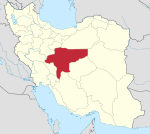| Jameh Mosque of Nushabad | |
|---|---|
 | |
| Religion | |
| Affiliation | Islam |
| Province | Isfahan Province |
| Location | |
| Location | Nushabad, Iran |
| Geographic coordinates | 34°04′41.0″N51°26′14.6″E / 34.078056°N 51.437389°E |
| Architecture | |
| Type | Mosque |
| Completed | Seljuq dynasty until the Qajar dynasty |
The Jameh Mosque of Nushabad is related to the Seljuq dynasty until the Qajar dynasty and is located in Nushabad. [1] [2]

